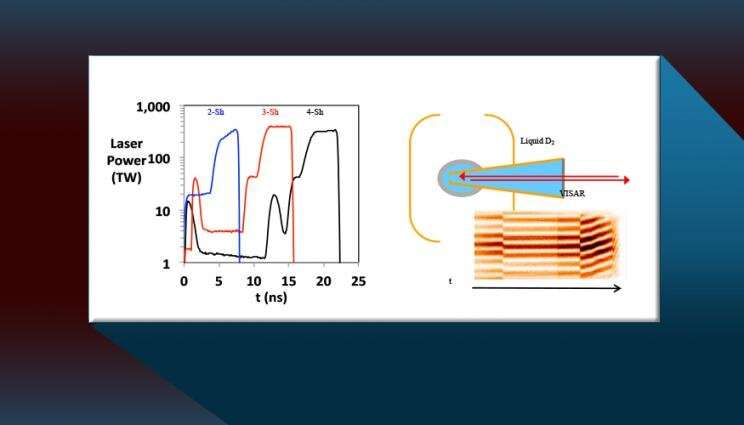1D model helps clarify implosion performance at NIF

In inertial confinement fusion (ICF) experiments at the National Ignition Facility (NIF), a spherical shell of deuterium-tritium fuel is imploded in an attempt to reach the conditions needed for fusion, self-heating and eventual ignition. Since theory and simulations indicate that ignition efficacy in one-dimension (1D) improves with increasing imploded fuel convergence ratio, it is useful to understand the sensitivity of the scale-invariant fuel convergence on all measurable or inferable 1D parameters.
In a paper featured in Physics of Plasmas, researchers have developed a compression scaling model that is benchmarked to 1D implosion simulations spanning a variety of relevant implosion designs. This model is used to compare compressibility trends across all existing indirect-drive layered implosion data for three ablators.
"The best level of compression of the various designs of indirect-drive implosions at NIF that have used plastic polymer and beryllium shells follow the expectations of a simple physics model," said Otto "Nino" Landen from Lawrence Livermore National Laboratory (LLNL) who served as lead author. "This has allowed us to rule out certain previously hypothesized effects such as hot electron preheat."
A major exception is the high-density carbon shells that have so far exhibited a remarkably constant lower level of compression, independent of the laser drive conditions, he said.
"Achieving ignition is fundamentally recognized as a trade-off between more energy coupled to the capsule requiring more efficient hohlraums or a larger laser, and improving the level of capsule compression," Landen said. "So, understanding what the NIF implosion database has told us so far about compression trends as we varied laser and capsule parameters seemed important as a first step to motivating further research in improving compression without necessarily resorting to a higher laser energy demand."
This trending work is part of improving understanding of and optimizing ICF implosion performance on the quest for robust ignition that also could be applied to the direct-drive ICF database.
The work was conducted by first validating a simple analytic model for the level of capsule compression as a function of various laser and capsule parameters by comparing to 1D simulations.
Researchers then compared the compression model scaling to all NIF cryogenic implosions shot to date using a combination of existing optical, X-ray and nuclear data, so essentially a physics-grounded empirical approach. This also required developing approximate analytic models for relating the expected compressibility of the implosion to the X-ray driven pressure profile applied to it in the hohlraum as measured by the NIF VISAR system.
Landen said that since high-density carbon shells are currently giving the best neutron yields despite the reduced compression trends presented in this paper, researchers have increased focus on testing physics-based hypotheses such as hydrodynamic instabilities leading to mixing between the shell and DT, and as yet untested schemes for improving compression in high-density carbon shell implosions.
More information: O. L. Landen et al. Fuel convergence sensitivity in indirect drive implosions, Physics of Plasmas (2021). DOI: 10.1063/5.0033256
Journal information: Physics of Plasmas
Provided by Lawrence Livermore National Laboratory





















